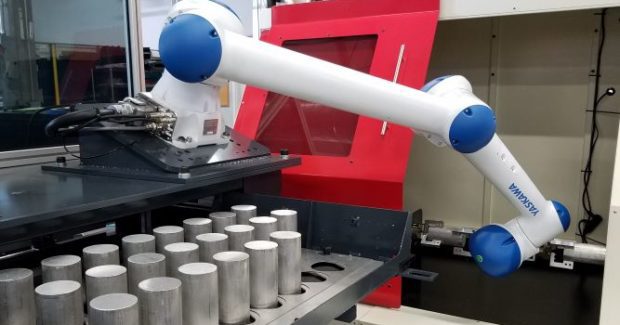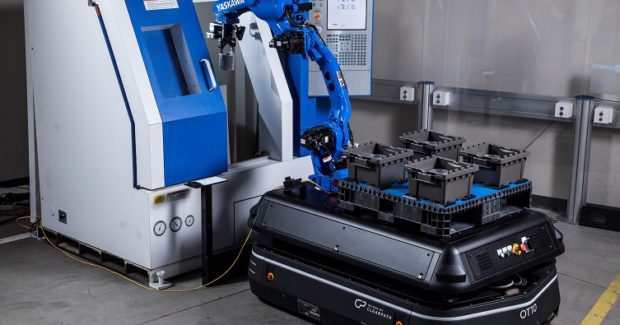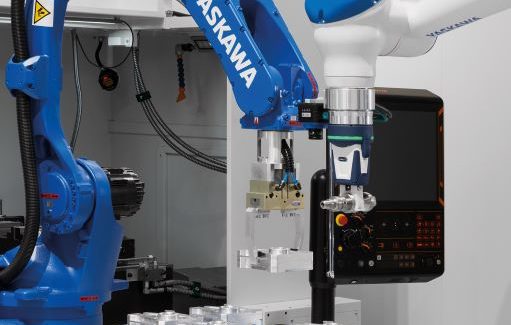Robotic Machine Tending for Optimized Operations
An increasing number of facilities are using flexible, portable robot platforms, which can be maneuvered throughout a factory to perform tasks. By robotically automating one or more elements on the shop floor, machine shops can not only increase productivity and OEE, but also realize a better ROI.
Posted: October 18, 2021
ADVANCING AUTOMATION
By Dean Elkins
More affordable, extremely reliable and highly flexible robots are reigniting interest toward robotic automation. Capable of enabling versatile production environments that fill the uptick in consumer demands, establish agile supply chains and adapt to labor shortages, robots and their innovative peripherals help manufacturers compliment current operations, creating intelligent factories primed to deal with rising challenges.
Along with implementing high performance welding robots and workcells, fabricators are also realizing that the use of robotic automation for machine tending tasks can greatly enhance production. Whether loading or unloading a CNC machine, or tending another piece of equipment for grinding, stamping, trimming and more, highly repeatable robots can expertly orient and transport parts, minimizing human error, increasing worker safety, optimizing system utilization and facilitating greater efficiency.
Manufacturers looking to address stringent demands should not overlook the potential value robots can have on machine tending applications – as many companies that commit to this type of integration experience transformative benefits:
HIGHLY APPEALING ROI
Once used in very controlled environments where low-mix, high-volume runs were the only viable and cost-effective option for reasonable return on investment (ROI), the right flexible robotic system can make a world of difference. Because of their perceived ROI over a given payback period, the use of industrial and collaborative robots for machine tending continues to be a leading option for company leaders looking to quickly address production inefficiencies.
BETTER WORKER UTILIZATION
Robots are deployed across the world to conquer dull, dirty and dangerous applications, completing a plethora of labor-intensive and high-turnover tasks. Not only do reliable and efficient robots fill the void when human employees are physically unable to fulfill certain duties, but also, robotic automation can free workers to perform more value-added tasks.
Loading and unloading a machine for an entire shift, day after day, often leads to employee boredom, burnout and occasionally ergonomic injury. Implementing robots and allowing workers to embrace other responsibilities like shorter runs, programming jobs or planned maintenance activities is a win-win. In fact, workers that are redeployed to other areas of a facility are usually more productive, as renewed enjoyment for their trade is discovered. Overall, the right mix of robots to human workers often results in higher, more stable, production.
EFFICIENT MACHINE MANAGEMENT
There is an adage that says, “if a machine isn’t running, you’re not making money.” While there is obviously more to maintaining a successful business, it is true that the ability to make parts for a customer relates directly to getting paid. That said, increasing revenue, typically equates to making more good parts. Depending on resource availability, achieving the necessary throughput may be challenging. Robotic automation enables industrial machines to work with minimal or no human intervention throughout entire shifts, enabling lights-out operations. Not only is this advantageous to manufacturers wanting to accommodate larger product volumes, but also, it offers a way for company leaders to balance worker shortages when minimizing human contact is necessary for safety concerns.
EXTREMELY CONSISTENT HANDLING
Many manual or pre-existing automated tasks can be advanced via the implementation of a machine tending robot, especially where consistency is concerned. Whether a CNC machine needs to be loaded or unloaded, or a metal stamping line needs a steady flow of parts, implementing a robotic solution is ideal for optimizing product workflow. Moreover, robotic machine tending ensures parts will be handled the same way every time, mitigating product damage caused by manual transfer.
ENHANCED EQUIPMENT EFFECTIVENESS
For most manufacturers, the “throughput struggle” is real. To increase productivity and strive for 100 percent effectiveness, company leaders are placing a larger focus on Overall Equipment Effectiveness (OEE) to measure the efficiency of individual machines, automated workcells, production lines and even entire facilities. A dimensionless parameter, OEE is the product of three factors: availability, performance and quality. Not only do the metrics provided from calculating these factors serve as an excellent gauge for measuring current equipment effectiveness, but also, they serve as a good motivator for robotic implementation — always with the goal of producing good parts.
The use of robust yet easy-to-use robots that are easily integrated into existing operations for the purpose of consistent part handling can optimize current equipment usage. Furthermore, robotically automating one or more elements on the shop floor, can help manufacturers increase productivity and OEE, lowering operational costs for a better ROI.
COST-EFFECTIVE PROJECT IMPLEMENTATION
Many small- to medium-size companies, especially those in high-mix, low-volume production environments often lose valuable time by halting equipment to swap out components. An ideal solution for these job shops would be to implement an easy-to-load system with flexible options. Multiple robot system integrators offer pre-engineered robotic machine tending solutions to ensure reliable part loading and unloading while mitigating changeover time. Overall, this translates into an easier, more cost-effective project start up.
USER-FRIENDLY INTEGRATION PROCESS
Off-the-shelf kits also offer step-by-step, easy-to-use interfaces that further accelerate the integration process. While it is possible for some robots to be interfaced directly into a machine tool with a factory interface option, most will need to be configured with a communication interface such as EtherNet I/P or Profinet. Machine status information can be displayed on a system human machine interface (HMI). As a bonus, safety can also be increased due to the reduction of the robot control wiring required.
From robots, workcells and grippers, to software and more, robot OEMs are continually developing transformative technologies to deliver better consistency, efficiency and quality where machine tending is concerned. When it comes to robots, small and lightweight six-axis models with innovative tooling are being mounted close to workpieces and other machinery in existing lines or workcells. These extremely fast, compact robots are popular for extracting machined parts out of chucks or for loading small press brakes. Similarly, higher IP wrist ratings have enhanced capabilities for applications using cutting fluids, and higher moment and inertia ratings are better addressing large part handling requirements.
A budding trend, a growing number of facilities are implementing highly flexible portable robot platforms. Capable of being maneuvered through a factory to perform the task in which they are needed, these robotic platforms make it easy for manufacturers to redeploy industrial and collaborative robots, as needed, to help with machine tending tasks where having a dedicated robot is not practical. Conversely, stationary robots designed to work collaboratively are facilitating the loading and unloading of items on and off AGVs (Automated Guided Vehicles). This type of robot usage helps to quickly, accurately and ergonomically handle products for organized material transfer and consistent throughput of goods.
Overall, the implementation of robotic automation for machine tending can add value to operations in more ways than one. Manufacturers that weigh these concepts and combine best practices with robust user-friendly robots equipped with innovative peripherals will more than likely add greater flexibility on the shop floor, meeting increased customer demands and paving the way for a more productive future.














